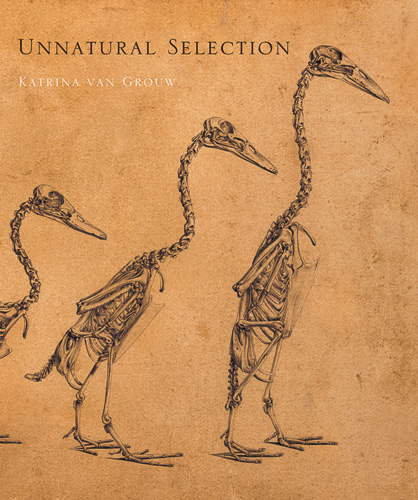
A strong contender for my favourite museum is the Natural History branch of the National Museum of Ireland, known locally as The Dead Zoo. It contains none of the child-friendly, interactive gimmickry that seems to blight most museums these days; it’s simply score after score of traditional wood-and-glass cases packed with dead animals, with no hint of a card inviting you to ‘interpret’ the ‘experience’.
In one respect, Katrina van Grouw’s wonderful coffee-table book Unnatural Selection reminded me very much of the Irish Natural History Museum: it has a distinctly old-fashioned feel to it, containing as it does a huge number of fabulous, meticulously detailed, hand-drawn illustrations of selectively bred animals and their skeletons. They’re the sort of illustrations you might expect to find reproduced as etchings in weighty Victorian tomes on animal husbandry. But, thanks to modern image-reproduction technology, the illustrations in this book are far more subtle than any etching. And they really are very wonderful indeed: exquisite drawings of dogs and pigs, pigeons and poultry, sheep, cattle and even budgerigars.
There, the similarity with the Irish Natural History Museum ends. Although the images are undoubtedly the star of the show, they’re accompanied by well-researched text concerning the selective breeding of animals by man.
Unnatural Selection has been published to mark the 150th anniversary of Charles Darwin’s long, lesser-known work The Variation of Animals and Plants under Domestication. Darwin saw natural selection of organisms in the wild as closely analogous to the selective breeding of domesticated species by humans (the unnatural selection of this book’s title). We might not always think of them in that way, but van Grouw rightly treats domesticated animals as every bit as ‘animal’ as the wild animals from which they’re descended. Whether or not they’re allowed to survive and reproduce by their human breeders is simply another case of selection in action. Perceived usefulness and/or appeal to humans becomes just one more selective pressure on domesticated species: one that can slew their evolution in ways natural selection in the wild might never allow.
I was particularly taken by van Grouw’s excellent example of the British bulldog to illustrate how selective pressures can change for domesticated animals, thereby causing them to evolve new forms. Before the introduction of animal cruelty laws in the UK, bulldogs, as their name implies, were selected for their ability to fight bulls. This selection was carried out primarily (and unwittingly) by the bulls themselves: those dogs that were unsuccessful at fighting bulls, unsurprisingly, tended not to leave many offspring! Once bull-baiting was banned, bulldogs continued to be bred for show purposes. Whether or not individual dogs were allowed to reproduce was now determined by how closely they matched the breeders’ ideal of what a bulldog should look like. The selective pressure had changed from fighting ability to meeting breeders’ aesthetic standards. The resulting change in the shape of bulldogs’ skulls was rapid and remarkable, as illustrated by van Grouw’s startling before and after illustrations. A modern-day pedigree bulldog would stand little chance in a face-off against an angry bovine.
Echoing Darwin, van Grouw divides her book into sections entitled ‘Origin’, ‘Inheritance’, ‘Variation’, and ‘Selection’. She covers a host of subjects, including species classification, plasticity of forms, selection and variation, the genetics of inheritance, mutations, and the various types of selection. Her text explores how the different factors that drive evolution affect domestic and wild species alike. Darwin would have loved this book.
My only (very minor) misgiving about the book was its sheer physical size. Even if I hadn’t been recovering from a hernia operation when he read it, I would have found a smaller book more manageable. But a smaller book would not do service to the marvellous illustrations. Between the competing selective pressures for a more manageable size and doing justice to the illustrations, the illustrations won out—as well they should.
Highly recommended.
- Buy this book from Bookshop.org (UK) and help tax-paying, independent bookshops.
- Buy this book from Amazon.co.uk
- Buy this book from Amazon.com
Disclosure: I received a free review copy of this book from the publisher.